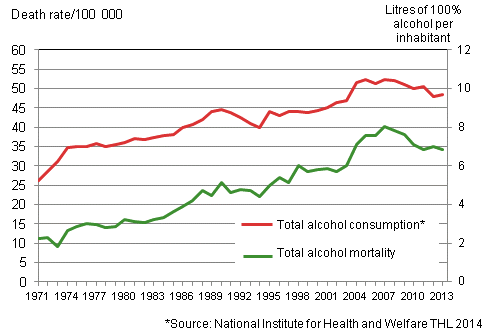4. Deaths from alcohol-related causes almost unchanged
Deaths related to the use of alcohol grew relatively evenly from the 1980s until 2003, after which deaths from alcohol-related causes increased by around one-quarter within a few years. The slow decrease in the number of deaths from alcohol-related causes that started in 2008 came to a halt in 2012. In 2013, age-standardised mortality from alcohol-related causes again decreased slightly from the previous year but was still clearly higher than in 2003. In 2013, good 1,900 persons died from alcohol-related diseases and alcohol poisonings. Of them, 1,500 were men and 400 women.
The most significant reason for high alcohol mortality is increased consumption of alcohol over the past decades. Since 2007, total alcohol consumption has decreased, however. In 2013, converted to 100% alcohol, the consumption was under 10 litres per capita (National Institute for Health and Welfare 2014). Changes in alcohol-related mortality has followed fairly regularly the graph for total consumption of alcoholic beverages even though alcohol-related deaths usually call for long-term detrimental use of alcohol that lasts for several years. The changes in the number of deaths from alcohol-related causes between 2009 and 2013 were mainly caused by changes in men's deaths from alcohol-related causes.
Alcohol-related deaths include both alcohol-related diseases and accidental poisonings by alcohol. Diseases related to long-term alcohol use, such as liver and heart diseases, cause a majority of deaths from alcohol-related causes. The share of alcohol poisonings in deaths from alcohol-related causes has decreased from 26 to 17 per cent over a ten-year period. Seventy-six per cent of those dying from alcohol poisonings were men.
Figure 6. Age-standardised mortality from alcohol-related diseases and accidental poisonings by alcohol and total consumption of alcohol in 1971 to 2013

Men die from alcohol-related causes clearly more often than women (Figure 7). Male mortality has also followed more closely changes in total consumption of alcohol. Women are lagging behind in alcohol statistics but women's mortality from alcohol-related causes has also risen evenly over several decades following men's mortality from alcohol-related causes.
Persons who died from alcohol-related causes are older than before. Over the past ten years, the mortality from alcohol-related causes of men aged 65 or over has grown faster than the mortality of all men. A majority, or seven out of ten, of those who died from alcohol-related causes are still of working-age. The share of aged people among deaths from alcohol-related causes is increasing, however. Over the past ten years, their share has grown by ten percentage points from 18 to 28 per cent.
In 2013, the share of alcohol-related causes in all deaths was four per cent. The meaning of alcohol as a cause of death is higher for middle-aged people than for retirement-age people because the mortality in these age groups as a whole is clearly lower than for older age groups. Among men who died between the ages of 45 and 54, alcohol-related causes were the cause of death for one-in-four, or 24 per cent and among those who died between the ages of 65 and 74 it was clearly lower at six per cent.
In addition to the underlying cause of death, alcohol is a contributing factor to death in many accidental deaths. The share of intoxication in accidents will be discussed in the following section.
Figure 7. Age-standardised mortality from alcohol-related diseases and accidental poisonings by alcohol in 1971 to 2013

Source: Causes of death, Statistics Finland
Inquiries: Airi Pajunen 029 551 3605, Jari Hellanto 029 551 3291, kuolemansyyt@stat.fi
Director in charge: Riitta Harala
Updated 30.12.2014
Official Statistics of Finland (OSF):
Causes of death [e-publication].
ISSN=1799-5078. 2013,
4. Deaths from alcohol-related causes almost unchanged
. Helsinki: Statistics Finland [referred: 19.4.2025].
Access method: http://stat.fi/til/ksyyt/2013/ksyyt_2013_2014-12-30_kat_004_en.html

